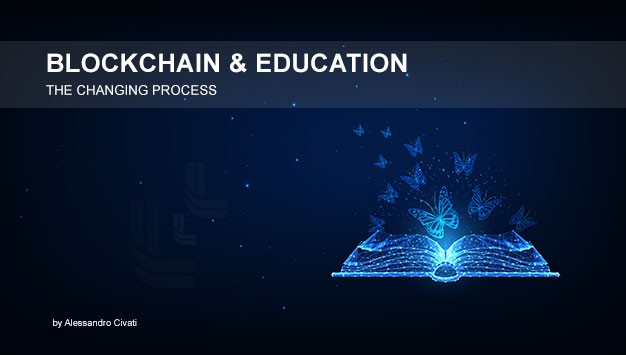Blockchain is essentially a distributed ledger technology more popular for being the technology backing cryptocurrencies such as Bitcoin and Ethereum. Blockchain technology can find widespread application in different economic sectors, including financial, education, healthcare, and security sectors.
As a distributed ledger technology, blockchain provides a transparent, verifiable register of transactions, which can help transform the education sector. One significant advantage of blockchain is that it is a decentralized technology that makes it secure and not susceptible to fraud. Different stakeholders have already deployed blockchain within the education ecosystem for various reasons, including improving learning opportunities. We have a look at how blockchain is transforming the education sector. The following points have an explanation about how blockchain is transforming the education sector.
Issuance and Verification of Academic Transcripts: Academic transcripts and certificates must be universally recognized and verifiable. For many educational institutions, verification of academic credentials is a manual process that involves case-by-case checking and documentation. Blockchain offers a way out in streamlining verification procedures and minimizing fraudulent incidents surrounding academic credentials.
In Europe, many Universities and High schools are collaborating with Lirax.Org, a software startup that launched a Blockcerts toolset that essentially provides an open infrastructure for the creation, issuance, viewing, and verification of blockchain-based certificates. However, design decisions need to be ironed out before the widespread deployment of DLT transcripts. According to company reference, the transcript service blockchain, called 8stamp, will help organizations keep comprehensive records to store location within systems, which creates a balance between portability and permanence.
Badges: A digital badge can be used to communicate and verify specific acquired skills. The technology can assemble multiple badges into a single place, allowing users to generate a passport that students/graduates can share with prospective employers. Indorse uses blockchain to verify e-portfolios whereby users upload claims, often with a verification link used by other users to verify the assertion.
Management of Student Records: DLT technology can be used to secure and share student records. The educational platform developed by Lirax.org uses blockchain to ensure student records. Experts portend that DLT technology may be best used as a directory rather than a data warehouse since storing student records can prove to be intensive and overly expensive.
Identity Management: Identity management is proving to be a massive problem in the education sector. We have seen several platforms allowing users to carry their identity with them when using the internet. Lirax and 8id have been leaders in providing identity on decentralized networks. Additionally, the apps also offer data portability.
Infrastructure Security: We have seen more schools installing security cameras and sensors, which increases the need for enhanced protection for their networks. Distributed ledger technology is offering the opportunity to secure networks from hackers. Xage is one company that is making use of blockchain’s tamper-proof ledgers to share security data across devices on a network.
Management of Libraries: Libraries at education institutions and across the board can benefit from DLT in expanding their service offering. DLT can enhance metadata archives, facilitate effective management of digital rights, and inform protocol for supporting community-based collection. In the USA, the Institute of Museum and Library Services works closely with the School of Information at San Jose State to explore blockchain technology’s potential in the information services sector.
Publishing: Blockchain technology can have a widespread application in the publishing industry. The technology will expand publishing options, address piracy issues, and assist with rights management, making it ideal for students, educators, and NGOs. The emergence of new platforms will lead to creating a level playing field that promotes more collaboration among authors, publishers, editors, and translators.
Great opportunities can be generated for this sector, like prove the authorship and allowing the writers to publish their work and get royalties on their intellectual material directly. The copyright is wholly owned by authors meaning that they can publish or distribute it elsewhere. Still inside the Lirax platform is available the possibility to streamline the publishing process. The system provides a secure and centralized catalog of files that are accessible to writers, editors, and publishers as per their roles, rights, and tasks.
Records Management: Blockchain technology can be used to increase accountability between authorities and students, and other stakeholders. It can be used to minimize fraud and reduce paper-based and manual processes. We have already seen the widespread use of DLT to secure and track records and increase the speed and efficiency of operations within different setups.
Transforming the Learning Marketplace: Blockchain technology has one main advantage of eliminating the middleman. Various educational institutions, right from prep school to the universities and other online-based schools, are using DLZT to create learning marketplaces. We have Tutor Application, which serves as a higher education marketplace helping teachers and students come together by making it easier to find, register and pay for courses from different educational institutions and individual teachers.
Management of Human Resources: Educational institutions, especially in higher education, have large human resources besides having verified educational qualifications, employment histories, and background checks. Many of these tasks are highly manual and time-consuming. The streamlining of these processes through DLT will help HR practitioners get more work done efficiently and faster. Large educational institutions such as universities will benefit immensely from adopting DLT in recruitment to conduct background checks and verify employment history.
In conclusion, there are other numerous areas of application of blockchain technology in the education sector. We will see the more widespread application of the technology in even areas that support the education sector. Blockchain transforming the education sector by streamlining verification procedures and minimizing fraudulent incidents. High potential exists in energy management, cloud storage, smart contracts, governance, charity, retail, and ridesharing that would drive the education sector forwards to achieve efficiency and meet educational objectives across all levels.

Author: Alessandro Civati
Email: author.ac@bitstone.net
LIPP (Lirax Intellectual Property Protection): https://lrx.is/v4ufOYLBU6


